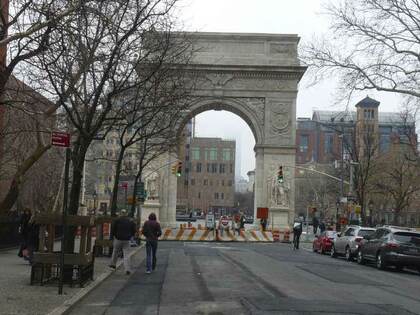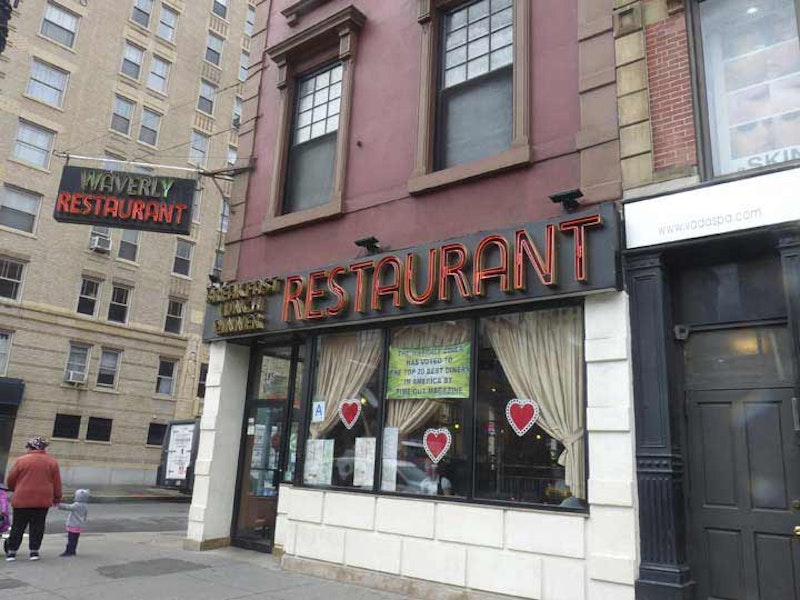The East Village, much of it originally a part of the Stuyvesant family farm, has been a redoubt of German, Polish and Ukrainian immigration over the decades, and Loisaida (the region between Aves. A and D), New York City’s chief downtown Hispanic enclave. Gentrification has robbed much of its old flavor, but also a lot of crime. That’s a tradeoff that urban strategists will have to debate. I wandered off down Waverly Pl. and E. 8th, eventually crossing into it.
Beginning at the W. 4th St. station, which serves the 6th and 8th Ave. subway lines (A,B, C, D, F, M) I walked east for a block on Waverly Pl. The Waverly Restaurant, a diner on the SW corner of 6th and Waverly, has a good diner-type neon sign with wraparound green and red neon signs, as well as a shingle overhanging the street. I’ve told the story before but in the early-2010s my friend Vicki and I were in the area, entered the Pizzeria Uno two doors down, got a booth, and sat there 15 minutes without being spoken to. So we took our business to the Waverly, where we had a decent lunch and were attended to as soon as we entered.

I never wore a watch for years. Finally in the 1990s I found a cheap plastic Mickey Mouse watch on Sanford Ave. in Flushing. Worked on a battery and didn’t need winding. When it gave out, I went through a number of cheap watches, until I finally got an iPhone in 2015, rendering carrying timepieces academic. This building, a former Emigrant savings bank on 6th just south of W. 8th that has kept its 1965-era look all these years despite divided up into other businesses, was what I depended on to give me the time for years when in the area, with the time and temperature displayed in two electronic message boards. When Emigrant moved out they were disconnected, but the clock’s still in place.

At W. 8th St. and 6th Ave., Greenwich Ave. heads northwest and divides the Greenwich Village street grid from the gridiron used in the rest of Manhattan working north from Houston St. Centuries ago, what became Greenwich Ave., 8th St. and Astor Pl. were all part of the same colonial-era foot and wagon path that may date back to the Native-American days.
A storefront on W. 8th just west of MacDougal depicted this corner in the 1920s, with a drugstore on one side and a Nedick’s on the other. For many years the Nedick’s space was home to a B. Dalton and later, a Barnes and Noble outlet that played host to me when the Forgotten New York the Book came out in 2006. After my spiel, I led a little tour in the Village for the 15-20 people who had come to hear me talk.
Back in the 1970s and into the 1980s, this stretch of W. 8th was home to record, clothing and head shops (which sold legal stuff in the front, marijuana in the back) as well as the 8th Street Playhouse, which showed the Rocky Horror Picture Show for years. The basement of the same building was home to Electric Lady Studios, where Jimi Hendrix, the Stones and the Clash all recorded. Hendrix lived on the block. These days, W. 8th St. is more somnambulant.

The Art Deco One Fifth Avenue (which is actually north of Two Fifth at Washington Square) opened in 1926 and is one of the tallest towers in Greenwich Village. Its former restaurant, also One Fifth, was frequented by scruffy college boys in our post-collegiate era in the 1980s, and its interior turned up in Woody Allen’s Crimes and Misdemeanors. I remember a wild cab ride south on Park after we got out of the first Keaton Batman flick in 1989, and we wound up here.

Looking south toward the Washington Square Arch, Stanford White’s memorial to the first president that was constructed from 1889 (the centennial of his inaugural) to 1892. It is decorated with sculptures of Washington in both his civilian and military guises by Alexander Stirling Calder and Herman MacNeil. If roads czar Robert Moses had gotten his wish, the circle around the fountain, which was once used to turn 5th Ave. buses and was open to motor traffic when the Queen of Avenues was one-way, and the fountain would be moved to make way for a connector road between 5th Ave. and LaGuardia Pl. Locals fought Moses (as they did against his proposed Lower Manhattan Expressway on Broome St.) and he eventually backed down. However, the fountain was moved between 2007-2011.

Washington Mews is one of nine separate routes named for George Washington in Manhattan. It’s a through alley between 5th Ave. and University Pl. and is lined with charming two-story cottages that were, at least on the south side, formerly stables used by the well-to-do residents of Washington Square North, the doings of which were described in 19th-century novels by Henry James. It’s the only street in NYC called a “mews” though there are many mewses in London. It’s marked by an old-style serifed street sign. The dwellings on the south side were constructed from 1850-1880 while the ones on the north side, in the 20th century.
The term “mews” is unusual: it derives from a French word meaning “to moult” and mewses were originally used in the 1300s to place cages confining falcons and hawks used by royalty for sport while they shed their feathers. Only later were the alleys used to house carriages. Just around the corner, at #3 Washington Square North and University Pl., was the studio where the painter Edward Hopper lived and worked from 1913 until his death in 1967.

The classic Cooper Union building still anchors Cooper Square as it has since 1859. The school was founded by inventor Peter Cooper, who laid the first transatlantic cable, ran the first successful railroad, and was the first producer of edible gelatin (the father of Jell-O). The school’s great hall was where Abraham Lincoln launched his presidential campaign in 1860; other speakers have included Mark Twain, Frederick Douglass, Susan B. Anthony and presidents Grant, Cleveland, Taft, Theodore Roosevelt, Wilson, Clinton and Obama.
The college is divided into three schools: the Irwin S. Chanin School of Architecture, the School of Art, and the Albert Nerken School of Engineering. It offers undergraduate and master’s degree programs exclusively in the fields of architecture, fine arts, and engineering. The school’s now flanked on each side by glass towers: 51 Astor Pl., completed in 2013. It’s home to IBM and a branch of St. John’s University, with a CVS drugstore on the ground floor. On the right is the undulating exterior of the Astor Place Tower, the “sculpture for living” residential tower designed by Charles Gwathmey in the early-2000s.
In the foreground is Tony Rosenthal’s nearly one-ton cubist sculpture called “Alamo,” installed in 1967; it can rotate if you push hard enough. It dominates the triangle formed by Cooper Square, E. 8th and Astor Pl. It’s so old now it frequently has to be carted off for repairs so it can be easily turned; the latest repair was earlier this year.

Fronting the narrow plot on Lafayette between Astor Pl. and E. 8th is the Astor Place Hotel, formerly known as the District 65 union hall, and before that, Clinton Hall and before that, the Mercantile Library, completed in 1892. According to NYC Landmarks, this Romanesque Revival building was designed by George E. Harney and constructed by the McCabe Brothers in 1890-92 for the Clinton Hall Association, which installed its Mercantile Library on the sixth and seventh floors. The mercantile library was founded in 1820 by the clerks of downtown merchants as a private reference and circulating library. Originally located on Fulton St., the organization erected the first Clinton Hall in 1830 at Nassau and Beekman Sts., moving in 1854 to the former Astor Place Opera House on the site of the present building.

Clinton Hall was once considered important enough to have its own entrance from the downtown IRT subway platform at Astor Pl., constructed in 1904. The stations were built in the days when you were sold a ticket and gave it to a second person who’d take it from you and put it in a ticket chopper. The building stands on the site of the Astor Place Opera House, where, in 1849, Nativist theatregoers rioted against the appearance of British actor William Macready. Twenty-two “patrons” were killed.

The former John Wanamaker Department Store Annex is one of the few NYC buildings that takes up an entire square block. The main store was a block to the north and was demolished decades ago. It was Wanamaker who demolished five units of Colonnade Row on Lafayette St. to make way for a truck warehouse, which still has his name on it. What’s little remembered is that a statue of Samuel S. Cox, Ohio congressman, Coast Guard sponsor, and “mailman’s friend,” originally stood here before being shuffled off to Tompkins Square Park.
The Astor Place subway station for years contained an entrance to Wanamaker’s and then a K-Mart (formerly Kresge’s) on the ground floor. K-Mart has vanished and the space is being converted to a Wegman’s supermarket.
—Kevin Walsh is the webmaster of the award-winning website Forgotten NY, and the author of the books Forgotten New York (HarperCollins, 2006) and also, with the Greater Astoria Historical Society, Forgotten Queens (Arcadia, 2013)

